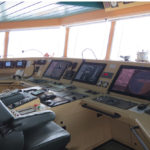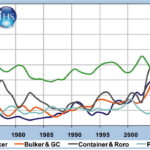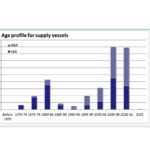The SAI Executive Meeting 2012 in Gothenburg reviewed prospects of shipping. It was concluded that the environment remains harsh but that every downturn bears chances, as long-term perspectives for worldwide trade are still positive.
The Swedish Institute of Shipping Analysis (SAI) was founded in 1993 with the mission to provide its members with in[ds_preview] depth market and shipping intelligence and analysis, summarized by the motto »It’s all about the future!« Traditionally, SAI invites executives of its members in the first days of a new year to Gothenburg in order to discuss actual trends and topics in shipping in the framework of lectures, podium discussions and a networking dinner.
On 18 and 19 January the roughly 60 participants of the SAI Executive Meeting 2012 – among them senior managers of Swedish and Scandinavian banks, the maritime industry and shipping, including majors like AP Møller and Stena – met in Gothenburg’s Museum of Art under the somewhat provoking headline »Survival of the fittest«. Supported by senior analysts of the information brokers IHS Fairplay and ODS Petrodata, they took a close look at latest market figures in all main sectors of sea transport as well as offshore shipping and discussed prospects and strategies to be among the fittest.
In his keynote speech, the Swedish award winning book author and media commentator Johan Norberg was setting the scene, summarizing four megatrends, which will form the background of culture, global business as well as political developments in the years to come:
»The world is getting bigger!«
The world population and GDP are growing. Even a year of crisis such as 2009 has been the second best in the history of economy. This means a tremendous increase and broad distribution of wealth, in particular in emerging countries, a success story of globalisation, despite all critics. In the past five years Europe’s GDP per capita has grown by 3 %, but in the rest of the world by 30 % (in China 45 %, in India 60 %). In 2015 South Koreans will in average be richer than all G7 citizens (except the US). According to the World Bank 500 mill. people less on the planet are living in poverty, compared to ten years ago. Urbanisation reaches new dimensions. 50 % of all Chinese live in cities now, compared with less than 20 % in the 1980s. Africa will be the next growth story, based on its resources, fertile land and people. The centre of gravity is shifting away from the »old world«. There will be more potential »middle class« clients, but also more competitors and rivals in all parts of the world. The good news: Shipping is the backbone of globalised transport, which is constantly growing with this trend.
»The world is getting smaller!«
The business models of Google and Facebook are prototypes of individualised niche strategies: advertisements and information are sent tailor-made according to the user’s profile. Major market players abandon the »dozen million dollar markets« and prepare for »millions of dozen dollar markets«. The dominance of »economy of scale« is to be questioned; room for smaller and clever business models is ample. However, in some cases like the upcoming consolidation of the container shipping market we experience exactly the opposite these months. Mobile means of communication and data handling are bringing the world together and give the individual tremendous opportunities. Demonstrations for freedom but also terrorist attacks can be organised via social media by almost anyone. Nothing can be hidden since the world is full of smart phone cameras. The stability of established systems can be shattered much easier, in positive and negative terms. For planning of policy and business this clearly means that more wildcards will have to be accepted in the future.
»The world is getting older!«
In Europe there will soon be less than two working people feeding one pensioner, compared with more than 3.5 at the time of creation of most social security systems, which will be extremely challenged in the near future. However, on medium term also emerging economies, which today benefit from the large young working generations, will face this challenge, but in a different population scale (in China quite dramatically, as soon as the »one child policy generation« will be fully at work.)
»The world is (financially) bust!«
We have just learned that the public budgets of most countries are in »over-debt«, so are many private households too. The times of easy financing and public deficit spending will be over, even if the central banks may flood the markets with fresh printed money. The stricter banking rules will hit all multi-million investment projects, such as those in the maritime world (shipping, shipbuilding and offshore activities). While some institutions and persons borrow, others are the lenders. Too much fresh money will definitely create the next bubbles. Ten meagre years appear the best case to come.
Against the background of these mega trends actual market figures were discussed. The general impression was that there are opportunities in every downturn. Carl-Johan Hagman, the new Stena CEO, who spent long periods of his career working
in the car carrier business, described this sector as a good example how disciplined stakeholders could take responsibility and deal with overcapacities in times of troubled markets, without violating anti-trust
legislation. Maersk Line’s CEO
for the North Europe Region, Michel Deleuran, explained the market leader’s strategy to enhance competitiveness by striving for step change goals in container transport, setting new standards in reliability, customer service and environmental footprint.
IHS Fairplay directors Christopher Pålsson and Niklas Bengtsson took the participants on a tour d’horizon through some major shipping sectors, supported by their UK colleague David Price, a dedicated coal market expert, and ODS Petrodata Principal Erik Simonsen, who presented the offshore supply vessel market.
Dry bulk
The mass of dry bulk shipped is predicted to grow by 8.1 % annually until 2015 to then around 5 bill. t. Because longer routes are playing an increasing role (e. g. Brazil–China) the demanded growth in shipping capacity will even be slightly higher. Iron ore (43 % of shipped tons) and coal (26 %) are the dominant cargoes, for which China and India in particular have developed a strongly increasing hunger for imports since 2009. The bulkcarrier fleet provides approximately 600 mill. tdw capacity today, thereof 42 % by Capesize and 25 % by Panamax ships. The capacity is predicted to grow by 8.9 % annually to more than 800 mill. tdw in 2015, with a nearly constant share of the large ships. Although deliveries are on record level 2010–2012, peaking at almost 100 mill. tdw p. a., also the removals in 2011 were aggressive and with 28 mill. tdw twice as high as in usual scrapping campaigns. This fact, balanced against the demand driven by Chinese energy consumption, construction and manufacturing, but also the industrial growth of the BRICKTIM countries (Brazil, Russia, India, China plus Korea, Turkey, Indonesia and Mexico), encouraged the analysts to issue moderately optimistic forecasts, despite the actual depressed rate level. Coal is the »make or break« factor. The fleet is relatively young, with 32 % more tonnage (203 mill. tdw) in the order book, 20 % of which are 200.000+ tdw and 33 % are Panamax.
Liquid bulk: tankers
The fundamentals appear stable: Oil will remain the backbone of the world’s energy production for further decades, with a slightly growing demand and supply until 2015. The mass of transported liquid bulk was some 3.6 bill. t in 2011, 50 % thereof crude, 24 % refined products, 14 % liquefied gases and 12 % chemicals. Liquid bulk is forecasted to grow per annum by around 7 % in the next few years, almost proportional for all commodities. However, since the refining capacities in Asia Pacific are growing twice as much as in the rest of the world in the next two decades, product and chemical transports will gain versus crude. The majority of the crude oil tanker fleet is rather young and again many deliveries are expected in 2012. Thus, the sector is »overbuilt«, which is reflected by a very low rate level (WS 50–80), with little hope for short-term recovery. However, the IHS analysts tend to see a tiny silver lining at the horizon, because seaborne crude transport likely will grow faster than the fleet in the next five years, and thus predict a medium term good outlook.
The product carrier fleet is expected to grow slower by 3.5 % p. a. until 2015, after annual growth rates of more than 10 % from 2006 to 2010 (mainly in the sizes above 20,000 tdw
and larger carriers above 60,000 tdw). Like in dry bulk, longer sailing distances will contribute to equalizing demand and supply, but there are still tough times ahead and rates are predicted to remain on relatively low levels at least for the next two years (WS 150–170).
Global LNG imports will more than duplicate in the coming two decades (4 % p.a.), while switches in several countries’ energy mix (e. g. Japan after Fukushima) may give the market some extra kicks. The LNG transport thus is a real business opportunity, which is meanwhile being picked up by many traditional crude oil shipping players. The LNG carrier fleet is soon closing in to almost 400 vessels, whereas the very large ships known as
»Q flex« (210,000 m³) or even »Q max« (250,000 m³) have turned out to be not flexible enough for worldwide trade. However, the present busy and early ordering activity (more than 50 ships in 2011, nearly all with the big Korean yards) may hamper the sector in the coming years.
Offshore supply vessels for oil and gas
The OSV market is driven by strong fundamentals. The offshore field development investments (CAPEX) are predicted to grow steady from 125 bill. $ in 2011 to 210 $ bill. in 2015 (CAGR ~ 16 %), thereof 40 % in Asia Pacific. The financial crunch 2008/2009 has slowed down activities temporarily while a large number of rigs and ships still were in the order pipeline.
This has led to overcapacities and lower rates, which will continue to be the situation until all newbuildings are digested by the market. ODS Petrodata estimates a present overcapacity of some 400 OSVs, many of them only usable for shallow and benign water tasks. Another actual problem for several operators is the sharp increase of operating cost (crew, fuel), which is not fully covered by the lower rates of today. ODS’s Erik Simonsen demonstrated that attrition and scrapping of older vessels could be the fast track back to a balanced market, provided that most of the vessels older than 25 years (25 % of the fleet) would be removed soon and less powerful middle-aged deep-water vessels would be deployed to benign water tasks. Although such strategies could make sense for European and American quality operators, most of the old ships are located in Asia Pacific, being »squeezed out« to their last minute, with no significant scrapping value expectations. However, the ongoing trend is a move from benign and shallow waters to deep-water and harsh environment projects, where the growth rates for rigs (floating), subsea construction vessels and support/
supply vessels will be two to three times higher.
Still valid business cases for shipbuilders, not only in Asia
IHS Fairplay counted the total world fleet with some 108,000 ships (1.56 bill. tdw) in the end of 2011, where around 3,825 vessels have been delivered, 3,150 vessels scrapped and nearly 2,000 new ships were contracted (actual total order book ~ 7.500 ships / 220 mill. tdw). 42.000 ships (135 mill. tdw) are older than 25 years, nearly 90 % of them smaller than 5.000 tdw, including general cargo / coasters, small tankers for chemicals, oil and gas, OSVs, tugs, service and fishing vessels, which are often built locally and form a significant niche potential for specialised yards, together with new ship type challenges outside the transport sector, such as offshore construction and maintenance vessels, e. g. for offshore wind farms.
In contrast to the above said, 40 % of the world tonnage (616 mill. tdw) is younger than five years, including many VLCCs, VLOCs, LNGCs and Megaboxers. This creates headaches for those yards, which are dependent on a high tdw output (and are no longer located in Europe), and has already led to another price war round in Asia. According to actual Chinese voices it could be doubted if 50 % of the yards in China will survive 2012. The big Korean yards meanwhile acquire approximately 50 % of their orderbook (in terms of revenue) from the offshore sector (rigs, drill ships, FPSO, FLNG). Looking ahead, the IHS analysts predicted an orderbook to fleet ratio of clearly below 20 % by 2015 for all ship types, as it was from 1980 to 2000, compared with 30–65 % in the boom between 2004 and 2009. They raised the question whether this would be good enough to serve medium- and long-term seaborne transport demands.
Are you ready for the next round of merchant shipbuilding cycle?

























